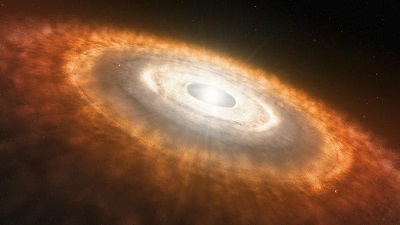Washington, (Asian independent) Using the James Webb Space Telescope, an international team of astronomers have provided the first evidence of water and other molecules in the highly irradiated inner, rocky-planet-forming regions of a disk in one of the most extreme environments in our galaxy.
The findings, published in The Astrophysical Journal, suggest that the conditions for terrestrial planet formation can occur in a possiblY broader range of environments than previously thought.
These are the first results from the eXtreme Ultraviolet Environments (XUE) James Webb Space Telescope programme, which focuses on the characterisation of planet-forming disks (vast, spinning clouds of gas, dust, and chunks of rock where planets form and evolve) in massive star-forming regions.
The XUE programme targets a total of 15 disks in three areas of the Lobster Nebula (also known as NGC 6357), a large emission nebula roughly 5,500 light-years away from Earth in the constellation Scorpius.
The Lobster Nebula is one of the youngest and closest massive star-formation complexes, and is host to some of the most massive stars in our galaxy.
Due to its location near several massive stars in NGC 6357, scientists expect XUE 1 to have been constantly exposed to high amounts of ultraviolet radiation throughout its life. However, in this extreme environment the team still detected a range of molecules that are the building blocks for rocky planets.
“We find that the inner disk around XUE 1 is remarkably similar to those in nearby star-forming regions,” said team member Rens Waters of Radboud University in the Netherlands. “We’ve detected water and other molecules like carbon monoxide, carbon dioxide, hydrogen cyanide, and acetylene. However, the emission found was weaker than some models predicted. This might imply a small outer disk radius.”
“We were surprised and excited because this is the first time that these molecules have been detected under these extreme conditions,” added Lars Cuijpers of Radboud University. The team also found small, partially crystalline silicate dust at the disk’s surface. This is considered to be the building blocks of rocky planets.
These results are good news for rocky planet formation, as the science team finds that the conditions in the inner disk resemble those found in the well-studied disks located in nearby star-forming regions, where only low-mass stars form. This suggests that rocky planets can form in a much broader range of environments than previously believed.
The team notes that the remaining observations from the XUE programme are crucial to establish the commonality of these conditions.
“XUE 1 shows us that the conditions to form rocky planets are there, so the next step is to check how common that is,” said team lead María Claudia Ramírez-Tannus of the Max Planck Institute for Astronomy in Germany.
“We will observe other disks in the same region to determine the frequency with which these conditions can be observed,” she added.
Webb is an international programme led by NASA with its partners, ESA (European Space Agency) and the Canadian Space Agency.








